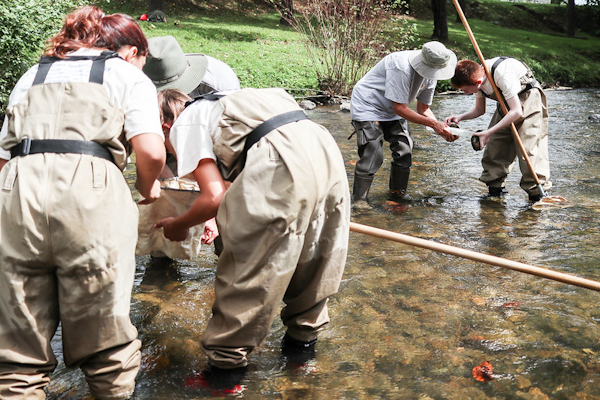SEJournal Online is the digital news magazine of the Society of Environmental Journalists. Learn more about SEJournal Online, including submission, subscription and advertising information.
 |
 |
| A government portal offers up hyperlocal data so users can easily assess the health of local waterways. Above, eighth graders collect samples from the Pigeon River in Haywood County, North Carolina. Photo: G. Peeples, U.S. Fish and Wildlife Service via Flickr Creative Commons (CC BY 2.0 Deed). |
Reporter’s Toolbox: Watershed Data … for the Rest of Us
By Joseph A. Davis
Finally: water quality data for nongeeks. The U.S. Environmental Protection Agency is offering a “How’s My Waterway?” web app that makes the sophisticated stuff simple.
If you are, indeed, a geek and want to jump ahead, you can start exploring it here. If not, read on.
A few months ago, Toolbox offered a look at the raw water quality data — for journalists who want to download it and perform their own analyses.
Here’s a portal for people
who just want to know
whether they can drink from
or swim in their local river.
But here’s a portal for people who just want to know whether they can drink from or swim in their local river. It’s hyperlocal and practical. It’s presented graphically and intuitively.
Where the data comes from
If you ask where the data came from, you risk getting into, er, deeper water. But from where we sit, it’s good data, and you don’t have to ask.
Of course, we always do. The good news is that the EPA answers the question. The other good news is that it comes from multiple authoritative datasets. Much of that data is required by law to be collected by government agencies and is therefore fairly good.
Those datasets include ATTAINS, a collection of water quality data posted by the states, and BEACON 2.0, a collection of state data about beach closings.
There’s also the National Listing of Fish Advisories, state-supplied data about warnings on eating fish, not to mention the National Stormwater Calculator and the Rainfall Erosivity Factor Calculator, which can help predict stormwater pollution.
It also includes discharge permit information, as well as permit violations. And drinking water information. And, yes, more. Here’s the full list.
How to use the data smartly
You don’t have to actually be that smart to use this data, not really. The EPA has worked hard to help you shoehorn into it.
The agency offers webcasts, an educators’ section, a widget for your phone and instructions on how to use it, plus an introductory video on YouTube.
You punch in a ZIP code or street address and it gives you a map.
In the process of describing state
and national-level water quality,
it actually provides some
meaningful overview analysis.
Like a good pair of binoculars, it allows you to zoom in or out, or to ask about water quality at the local, state or national level. In the process of describing state and national-level water quality, it actually provides some meaningful overview analysis.
The data is not up-to-the-second, but it is pretty current. The time frame differs for each kind of data.
As we will never tire of reminding you, data is only the beginning of the story — a launch pad for shoe-leather and phone reporting. It’s always wise to groundtruth what the data tells you.
[Editor’s Note: For more, visit our Topic on the Beat: Water & Oceans page, which includes more Toolboxes, plus TipSheets, Backgrounders, Features and more, as well as water headlines from our EJToday news curation service.]
Joseph A. Davis is a freelance writer/editor in Washington, D.C. who has been writing about the environment since 1976. He writes SEJournal Online's TipSheet, Reporter's Toolbox and Issue Backgrounder, and curates SEJ's weekday news headlines service EJToday and @EJTodayNews. Davis also directs SEJ's Freedom of Information Project and writes the WatchDog opinion column.
* From the weekly news magazine SEJournal Online, Vol. 9, No. 3. Content from each new issue of SEJournal Online is available to the public via the SEJournal Online main page. Subscribe to the e-newsletter here. And see past issues of the SEJournal archived here.











 Advertisement
Advertisement 



